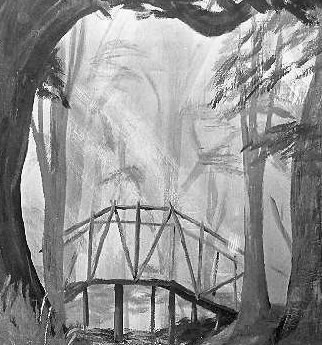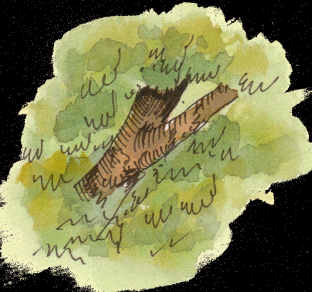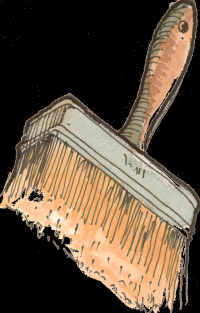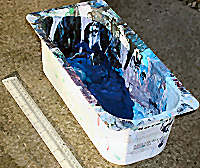TREES Page five
How I go about painting trees and forests on Backcloths; Flats and Wings.

You need care painting these. I dip my five inch wide brush into white paint then 'thin' the colour out by brushing a few strokes on a scrap piece of board (often the back of a flat). Then I apply the 'shafts' on the cloth or flat. It is important these shafts are straight with no wobbles. I paint my shafts right across the background trees then redo some of those trunks.
Some trunks I will make lighter on the side of the sun as if that is where the light is striking. Others I will paint in silhouette as if they are in front of the light.
Detail of Babes in Wood cloth
BOUGHS AND TRUNKS IN FOLIAGE
 |
The trunk and boughs do not end where the foliage starts, but can be seen peeping through the leaves. I usually paint these in after I have painted the foliage. Taking care to keep the geometry right and constructing them from where you can see the trunk below the canopy line. |
WATER In a woods is great.

It gives a nice colour contrast and an interesting different element. It needn't be a thunderous waterfall. I'm talking of a little pool or puddle here and there. Or perhaps a small, still stream. I emphasise 'still' because I personally try to avoid painting anything moving:- seagulls; fire; water etc.
Water gives an excuse to paint in reflections too.
DRIFTS OF FLOWERS
I use a wide wallpaper paste brush to paint bluebells, snowdrops, etc in the distance. I dip the brush into its colour then dab or jab onto my canvas or board. And no wiping the excess on the lip of the container before doing this.
I'm aiming for small spots of colour so it is not brushed on as is normal painting but dabbed on.

Nearer flowers I will paint in more detail. And don't forget even flowers cast shadows too.
 |
Incidentally don't do this dipping-the-brush technique into your original tin of paint but decant some into a shallow tray and work from there. Otherwise you will taint your original colour in that tin. I use oblong ice cream containers to hold my paints. |
HINT
Using a wide wallpaper paste brush is great for painting heather in the foreground. Dip your brush into a heather colour then dip one end of that same brush into white. Now dab onto your canvas/board taking care to put the white end of the brush where the sun is lightening your heather.
The heather in the bottom of this photo is in two clumps each about one foot wide
Photo is a detail of a wing for Brigadoon

| << Return to list of Stage Sets | END OF HOW TO PAINT TREES |